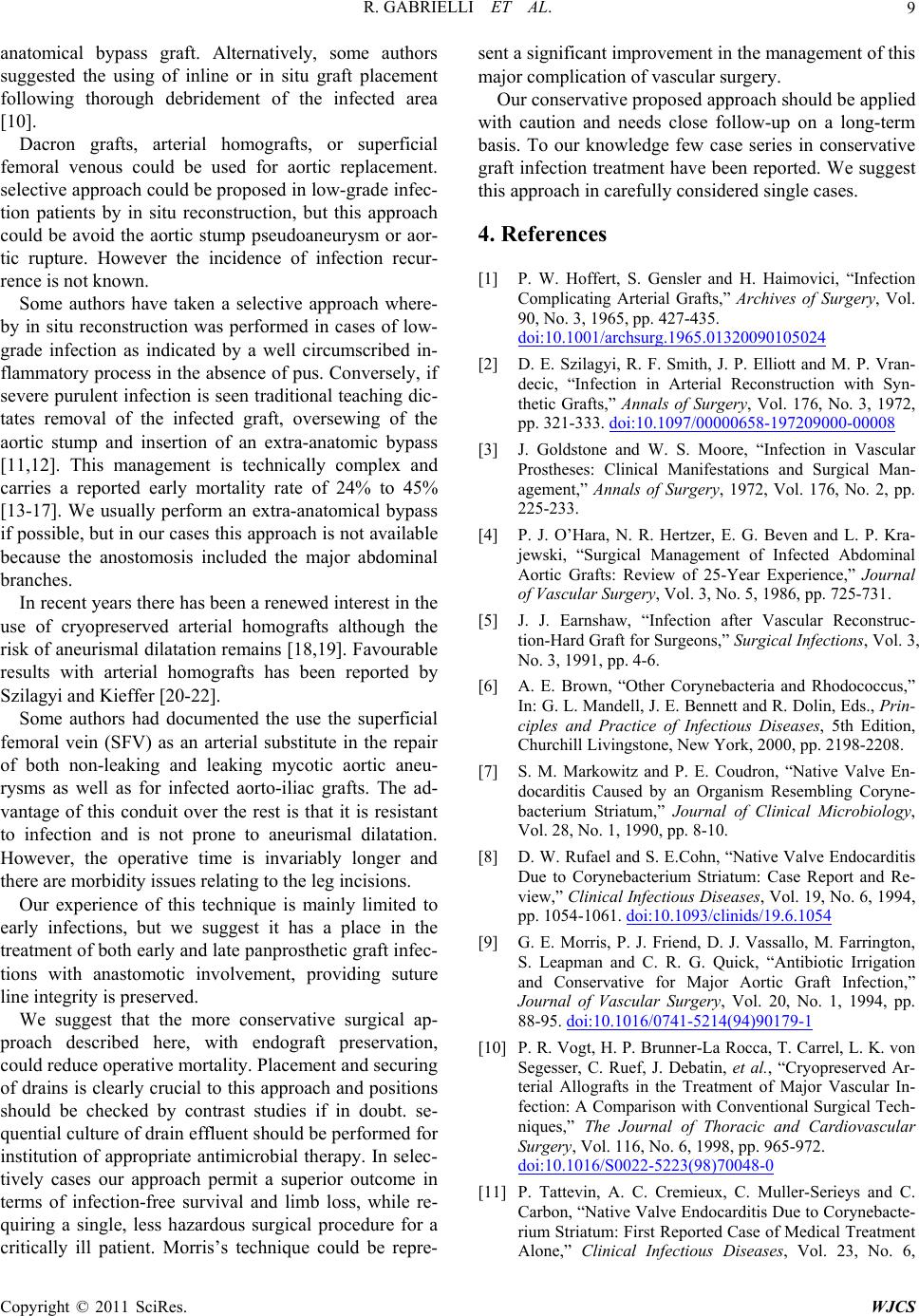
R. GABRIELLI ET AL.
Copyright © 2011 SciRes. WJCS
9
anatomical bypass graft. Alternatively, some authors
suggested the using of inline or in situ graft placement
following thorough debridement of the infected area
[10].
Dacron grafts, arterial homografts, or superficial
femoral venous could be used for aortic replacement.
selective approach could be proposed in low-grad e infec-
tion patients by in situ reconstruction, but this approach
could be avoid the aortic stump pseudoaneurysm or aor-
tic rupture. However the incidence of infection recur-
rence is not known.
Some authors have taken a selective approach where-
by in situ reconstruction was performed in cases of low-
grade infection as indicated by a well circumscribed in-
flammatory process in the absenc e of pus. Conversely, if
severe purulent infection is seen traditional teaching dic-
tates removal of the infected graft, oversewing of the
aortic stump and insertion of an extra-anatomic bypass
[11,12]. This management is technically complex and
carries a reported early mortality rate of 24% to 45%
[13-17]. We usually perform an extra-anatomical bypass
if possible, but in our cases this approach is not available
because the anostomosis included the major abdominal
branches.
In recent years there has been a renewed interest in the
use of cryopreserved arterial homografts although the
risk of aneurismal dilatation remains [18,19]. Favourable
results with arterial homografts has been reported by
Szilagyi and Kieffer [20-22].
Some authors had documented the use the superficial
femoral vein (SFV) as an arterial substitute in the repair
of both non-leaking and leaking mycotic aortic aneu-
rysms as well as for infected aorto-iliac grafts. The ad-
vantage of this conduit over the rest is that it is resistant
to infection and is not prone to aneurismal dilatation.
However, the operative time is invariably longer and
there are morbidity issues relating to the leg incisions.
Our experience of this technique is mainly limited to
early infections, but we suggest it has a place in the
treatment of both early and late p anprosthetic gr aft infec-
tions with anastomotic involvement, providing suture
line integrity is preserved.
We suggest that the more conservative surgical ap-
proach described here, with endograft preservation,
could reduce operative mortality. Placement and securing
of drains is clearly crucial to this ap proach and positions
should be checked by contrast studies if in doubt. se-
quential culture of drain effluent should be performed for
institution of appropriate antimicrobial therapy. In selec-
tively cases our approach permit a superior outcome in
terms of infection-free survival and limb loss, while re-
quiring a single, less hazardous surgical procedure for a
critically ill patient. Morris’s technique could be repre-
sent a significant impro ve ment in the mana ge ment of th is
major complication of vascular surgery.
Our conservative proposed approach should be applied
with caution and needs close follow-up on a long-term
basis. To our knowledge few case series in conservative
graft infection treatment have been reported. We suggest
this approach in carefully considered single cases.
4. References
[1] P. W. Hoffert, S. Gensler and H. Haimovici, “Infection
Complicating Arterial Grafts,” Archives of Surgery, Vol.
90, No. 3, 1965, pp. 427-435.
doi:10.1001/archsurg.1965.01320090105024
[2] D. E. Szilagyi, R. F. Smith, J. P. Elliott and M. P. Vran-
decic, “Infection in Arterial Reconstruction with Syn-
thetic Grafts,” Annals of Surgery, Vol. 176, No. 3, 1972,
pp. 321-333. doi:10.1097/00000658-197209000-00008
[3] J. Goldstone and W. S. Moore, “Infection in Vascular
Prostheses: Clinical Manifestations and Surgical Man-
agement,” Annals of Surgery, 1972, Vol. 176, No. 2, pp.
225-233.
[4] P. J. O’Hara, N. R. Hertzer, E. G. Beven and L. P. Kra-
jewski, “Surgical Management of Infected Abdominal
Aortic Grafts: Review of 25-Year Experience,” Journal
of Vascular Surgery, Vol. 3, No. 5, 1986, pp. 725-731.
[5] J. J. Earnshaw, “Infection after Vascular Reconstruc-
tion-Hard Graft for Surgeons,” Surgical Infections, Vol. 3,
No. 3, 1991, pp. 4-6.
[6] A. E. Brown, “Other Corynebacteria and Rhodococcus,”
In: G. L. Mandell, J. E. Bennett and R. Dolin, Eds., Prin-
ciples and Practice of Infectious Diseases, 5th Edition,
Churchill Livingstone, New York, 2000, pp. 2198-2208.
[7] S. M. Markowitz and P. E. Coudron, “Native Valve En-
docarditis Caused by an Organism Resembling Coryne-
bacterium Striatum,” Journal of Clinical Microbiology,
Vol. 28, No. 1, 1990, pp. 8-10.
[8] D. W. Rufael and S. E.Cohn, “Native Valve Endocarditis
Due to Corynebacterium Striatum: Case Report and Re-
view,” Clinical Infectious Diseases, Vol. 19, No. 6, 1994,
pp. 1054-1061. doi:10.1093/clinids/19.6.1054
[9] G. E. Morris, P. J. Friend, D. J. Vassallo, M. Farrington,
S. Leapman and C. R. G. Quick, “Antibiotic Irrigation
and Conservative for Major Aortic Graft Infection,”
Journal of Vascular Surgery, Vol. 20, No. 1, 1994, pp.
88-95. doi:10.1016/0741-5214(94)90179-1
[10] P. R. Vogt, H. P. Brunner-La Rocca, T. Carrel, L. K. von
Segesser, C. Ruef, J. Debatin, et al., “Cryopreserved Ar-
terial Allografts in the Treatment of Major Vascular In-
fection: A Comparison with Conventional Surgical Tech-
niques,” The Journal of Thoracic and Cardiovascular
Surgery, Vol. 116, No. 6, 1998, pp. 965-972.
doi:10.1016/S0022-5223(98)70048-0
[11] P. Tattevin, A. C. Cremieux, C. Muller-Serieys and C.
Carbon, “Native Valve Endocarditis Due to Corynebacte-
rium Striatum: First Reported Case of Medical Treatment
Alone,” Clinical Infectious Diseases, Vol. 23, No. 6,